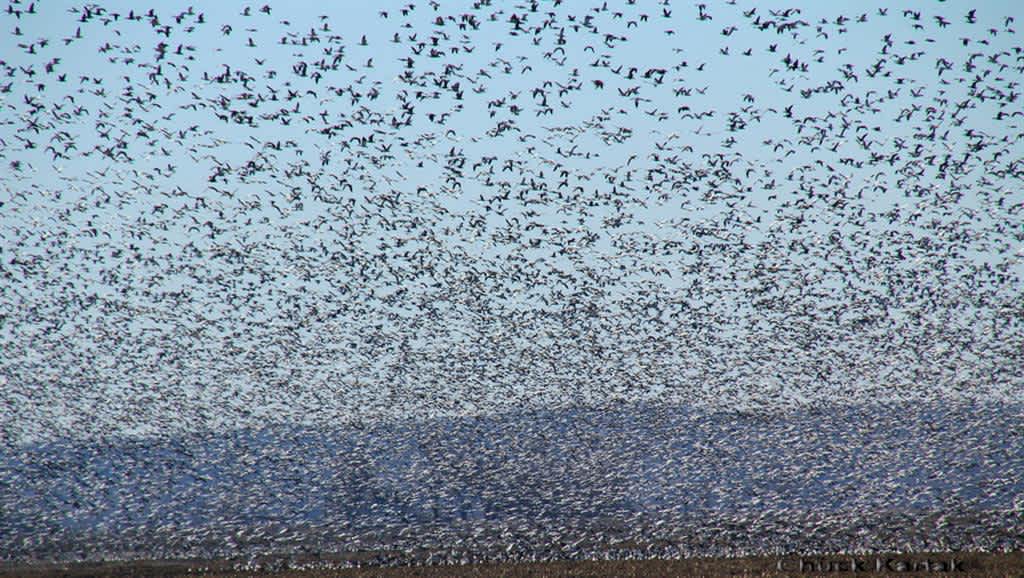Give Snow Goose Hunting a Shot This Spring
Bernie Barringer 02.25.15

If you’re a waterfowl hunter, you’re accustomed to a plug in your gun’s magazine that limits you to three shots at a time. You’re also used to strict bag limits and possession limits. But a hunter pursuing snow geese in the spring has no such restrictions. From Arkansas to the Canadian border, snow geese make their way north each spring in numbers that are hard to fathom. Goose hunters lie in wait all along the way, hoping to make a dent in the incredibly high population.
It wasn’t always this way. Snow geese rebounded from very low populations and the middle part of the 1900s. But by the end of the century snow goose populations were so high that they were decimating their nesting habitat in the tundra of Northern Canada. In an effort to control the exploding populations, biologists proposed a spring season. Soon it was evident that the spring season wasn’t having enough of an effect, so even more drastic measures were necessary. Bag limits have been eliminated, hunters now fit their shotguns with 10-round magazines, shotgun shells are purchased by the thousands, and huge decoy spreads are put out each spring. When the skies fill with snow geese, the hunters do their best to put a dent in the population.
There are guides and outfitters who follow the migration from the south to the north each year, and Duane Durr is one of them. “Most people don’t have the time or the money to buy hundreds of decoys set them up and lease the land necessary to take advantage of this amazing opportunity,” said Durr. “So for someone who wants to go on a guided goose hunt, it’s hard to imagine a better bang for the buck.”

The season begins around the first week in February and Arkansas. The snow geese follow the snow line north as the snow melts. “Snow geese really do not like snow,” according to Durr. “They fly north until they encounter snow and then they stop. If they run into a snowstorm they will actually retreat 100 or even 200 miles until they get out of it.” They work their way north until they reach their nesting grounds in Northern Canada.
Depending on the winter, this whole process can take three to four months. The shooting fades in North Dakota by late April most years. But in a late spring, or spring with a lot of late snowfall, hunting can take place well into May. In a general sense the geese follow the Missouri River corridor. The Prairie Pothole Region of eastern North and South Dakota provide some of the best shooting in March and April.
Typically the geese fly to water. The gravitate toward lakes, large marshes, and sloughs where they spend the daylight hours. Huge rafts of geese leave the lakes at the crack of dawn and fly out to the fields, where they feed for a couple hours in the morning. They spend the rest of the day either flying north or resting on the water. They tend to become predictable in their feeding patterns when bad weather stops them or they need to hold over for a few days to recuperate and fill their tummies.
Besides feeding in the morning, geese will often make a second visit to the fields in late afternoon. This is also the time when geese that have been flying all day are looking for a place to eat and some water on which to spend the night. Predators have a field day when these huge flocks of geese come through. And water is the safest place to be under the cover of darkness.
It’s not uncommon to see tens of thousands of geese in a day and on a good day, you might shoot 100 or more. Outfitters go out to the fields before daylight and shoot for two to three hours until the geese go back to water for the day. By mid-afternoon, the geese are coming to the fields again and the shooting goes until 30 minutes after sunlight in most states. “It’s a spectacle that has to be seen to believed at times,” Durr said. The average cost of a full day of shooting and a sore shoulder is about $150 per person.
All the shooting, of course, begs the question, what do you do with all those geese? Durr believes they are even better eating than Canada geese. “They have a lighter breast meat than Canadas,” he said. “They are excellent grilled or made into sausage; many people make them into jerky.” Many hunters fill up their smokers with the breast meat. The birds provide excellent eating and plenty of it.

If you have any interest at all in waterfall hunting, this is a hunt you really need to experience at least one time. There really is nothing else in North America that equals the incredible sights and sounds of tens of thousands of geese swirling around you as you try to pick out specific individuals to shoot at. Plus you’ll be doing your part to conserve critical tundra habitat. To reach Duane Durr, call him at 618-243-5421.
Follow Bernie’s bowhunting adventures on his blog, bowhuntingroad.com.

